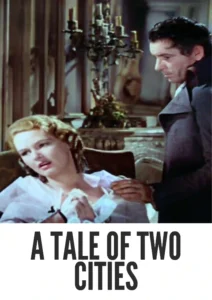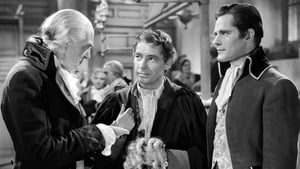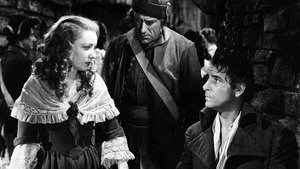Video Sources 0 Views

Synopsis
Revolution, Romance, and Redemption: A Tale of Two Cities (1935) in Vivid Color

Step back in time with A Tale of Two Cities, a sweeping historical drama from 1935, now beautifully colorized for a captivating viewing experience. Based on Charles Dickens’s timeless novel, this film delivers an epic story of love, sacrifice, and redemption against the backdrop of the French Revolution. Perfect for fans of classic literature and historical sagas, this HD download brings a beloved story to life with vibrant visuals and powerful performances. Also known as Dickens’ A Tale of Two Cities, it remains a cinematic treasure.
A Tale of Two Cities Storyline: Love and Sacrifice Amidst Revolution
A Tale of Two Cities tells the story of Charles Darnay (Ronald Colman), a French aristocrat who renounces his family’s name and fortune to escape the excesses of the French aristocracy, and Sydney Carton, a cynical English lawyer who finds redemption through his love for Lucie Manette (Elizabeth Allan).As the French Revolution erupts, Darnay returns to Paris to save a family servant, only to be imprisoned by the revolutionary regime. Carton, who bears a striking resemblance to Darnay, sees an opportunity to prove his love for Lucie by sacrificing himself in Darnay’s place. The film culminates in a powerful and emotional climax as Carton bravely faces the guillotine, uttering the iconic words, “It is a far, far better thing that I do, than I have ever done; it is a far, far better rest that I go to than I have ever known.” Ultimately, A Tale of Two Cities is a moving and unforgettable story about the triumph of love and self-sacrifice in the face of turmoil.
Movie Cast
The film features a stellar cast of actors who bring these memorable characters to life:
- Ronald Colman as Charles Darnay and Sydney Carton
- Elizabeth Allan as Lucie Manette
- Edna May Oliver as Miss Pross
- Reginald Owen as Jarvis Lorry
- Basil Rathbone as Marquis St. Evrémonde
Movie Genre
A Tale of Two Cities falls into the genre of historical drama, with elements of romance, adventure, and social commentary that are characteristic of classic Hollywood epics. Its sweeping scope, grand sets, and emotional depth make it a captivating and enduring film.
Historical Context: Dickens, Depression-Era Hollywood, and David O. Selznick
Released in 1935, A Tale of Two Cities was produced during the height of the Golden Age of Hollywood. Produced by David O. Selznick, known for Gone With The Wind, the film reflects the era’s fascination with literary adaptations and historical dramas. The film’s themes of social justice and sacrifice resonated with audiences during the Great Depression. A Tale of Two Cities remains a testament to the power of storytelling and the enduring appeal of Charles Dickens’s work.
Colorization Details
This colorized version of A Tale of Two Cities has been meticulously restored using modern digital techniques, enhancing the visual appeal while preserving the film’s original atmosphere. The colorization process involved carefully analyzing the grayscale tones of the original black and white footage and assigning appropriate colors to each scene. While the specific software used remains proprietary, the techniques employed included advanced algorithms for color palette selection and image enhancement. This painstaking process brings new life to the characters and settings, making the story even more engaging for modern audiences. While some may debate the merits of colorizing classic films, it introduces these films to a broader audience, ensuring their legacy for future generations.
Technical Details
- Director: Jack Conway
- Screenplay: W. P. Lipscomb, S. N. Behrman
- Based on: the novel by Charles Dickens
- Cinematography: Oliver T. Marsh
- Edited by: Conrad A. Nervig
- Production Company: Metro-Goldwyn-Mayer (MGM)
- Distributed by: Metro-Goldwyn-Mayer (MGM)
- Runtime: 128 minutes
Technical Specifications
- Download Format: MP4
- Resolution: HD (1080p)
- Compatibility: Compatible with most devices, including smartphones, tablets, computers, and smart TVs.
Reviews and Critical Reception
A Tale of Two Cities (1935) is widely regarded as a faithful and compelling adaptation of Charles Dickens’s novel, praised for its strong performances, lavish production values, and emotional impact. While it may not be considered one of the most innovative films of its era, it remains a powerful and moving cinematic experience that continues to resonate with audiences today. As a classic Hollywood adaptation of a beloved literary work, A Tale of Two Cities offers a timeless story of love, sacrifice, and redemption.
FAQs
- Q: What is A Tale of Two Cities about?
- A: A Tale of Two Cities is a historical drama about love, sacrifice, and redemption during the French Revolution.
- Q: Is A Tale of Two Cities (1935) a faithful adaptation of the novel?
- A: Yes, the film is widely regarded as a faithful and compelling adaptation of Charles Dickens’s novel.
- Q: Is this version of A Tale of Two Cities colorized?
- A: Yes, this version has been professionally colorized to enhance the viewing experience.
- Q: What makes A Tale of Two Cities a classic film?
- A: A Tale of Two Cities is a classic film due to its timeless story, strong performances, and lavish production values.
- Q: What is the download format?
- A: The download format is MP4, which is compatible with most devices.
- Q: What resolution is the download?
- A: The resolution is HD (1080p), providing a high-quality viewing experience.
Download Now in HD!
Watch A Tale of Two Cities Today!












